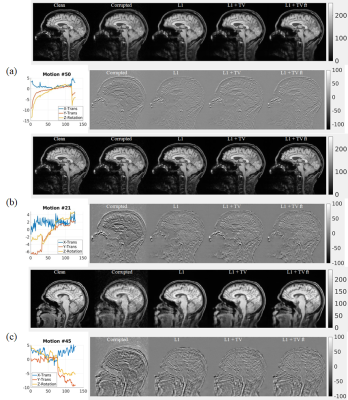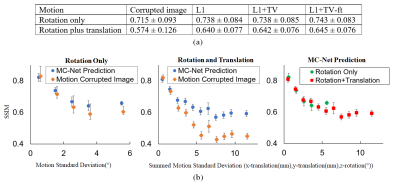Lei Zhang1, Xiaoke Wang1, Michael Rawson2, Radu Balan3, Edward H. Herskovits1, Linda Chang1, Ze Wang1, and Thomas Ernst1
1Department of Diagnostic Radiology & Nuclear Medicine, University of Maryland School of Medicine, Baltimore, MD, United States, 2Department of Mathematics, University of Maryland, College Park, MD, United States, 3Department of Mathematics and Center for Scientific Computation and Mathematical Modeling, University of Maryland, College Park, MD, United States
1Department of Diagnostic Radiology & Nuclear Medicine, University of Maryland School of Medicine, Baltimore, MD, United States, 2Department of Mathematics, University of Maryland, College Park, MD, United States, 3Department of Mathematics and Center for Scientific Computation and Mathematical Modeling, University of Maryland, College Park, MD, United States
We developed a novel deep learning approach for correction of large
movements in brain MRI. The proposed method improved image quality
compared with the motion corrupted images in terms of a quantitative
metric and visual assessment by experienced readers.

Rotation plus translation results.
The first row of each subfigure contains clean image, corrupted image,
motion correction result of L1, motion correction result of L1+TV, and
motion correction result of L1+TV ft, respectively. The second row of
each subfigure shows motion trajectory, residual image between corrupted
image and clean image, residual image between motion correction result
of L1 and clean image, residual image between motion correction result
of L1+TV and clean image, and residual image between motion correction
result of L1+TV ft and clean image, respectively.

(a)
SSIM (mean ± std) of the motion-corrupted images, L1, L1 + TV, and
L1+TV-ft, respectively.
(b) The proposed method successfully reduced the effect of motion. SSIM against the reference image is plotted as a measure of image
quality (0 is the lowest, 1 is the highest). The quality of MC-Net
predication is similar for input images with only rotational motion
and those with both rotational and translational motion.